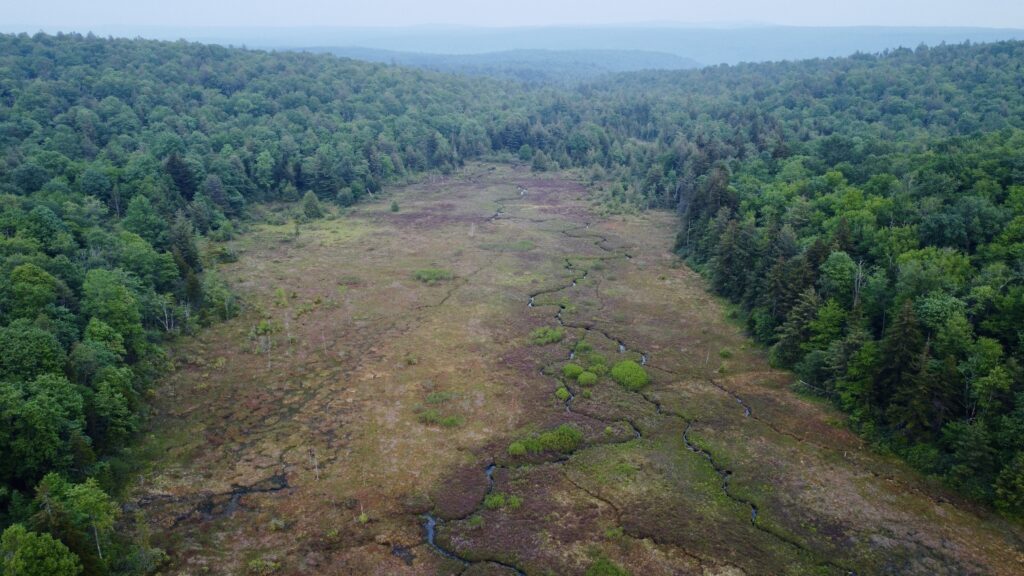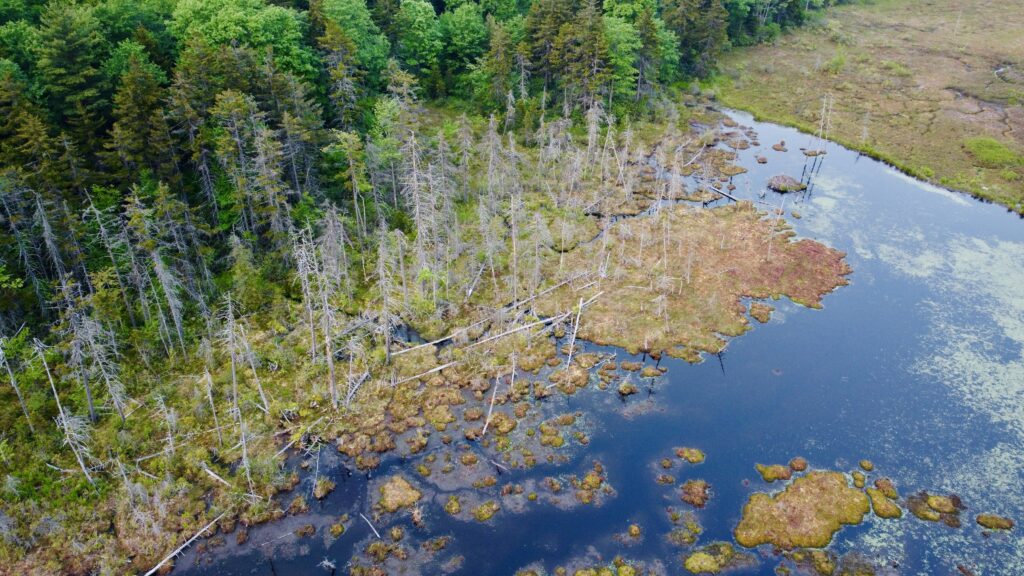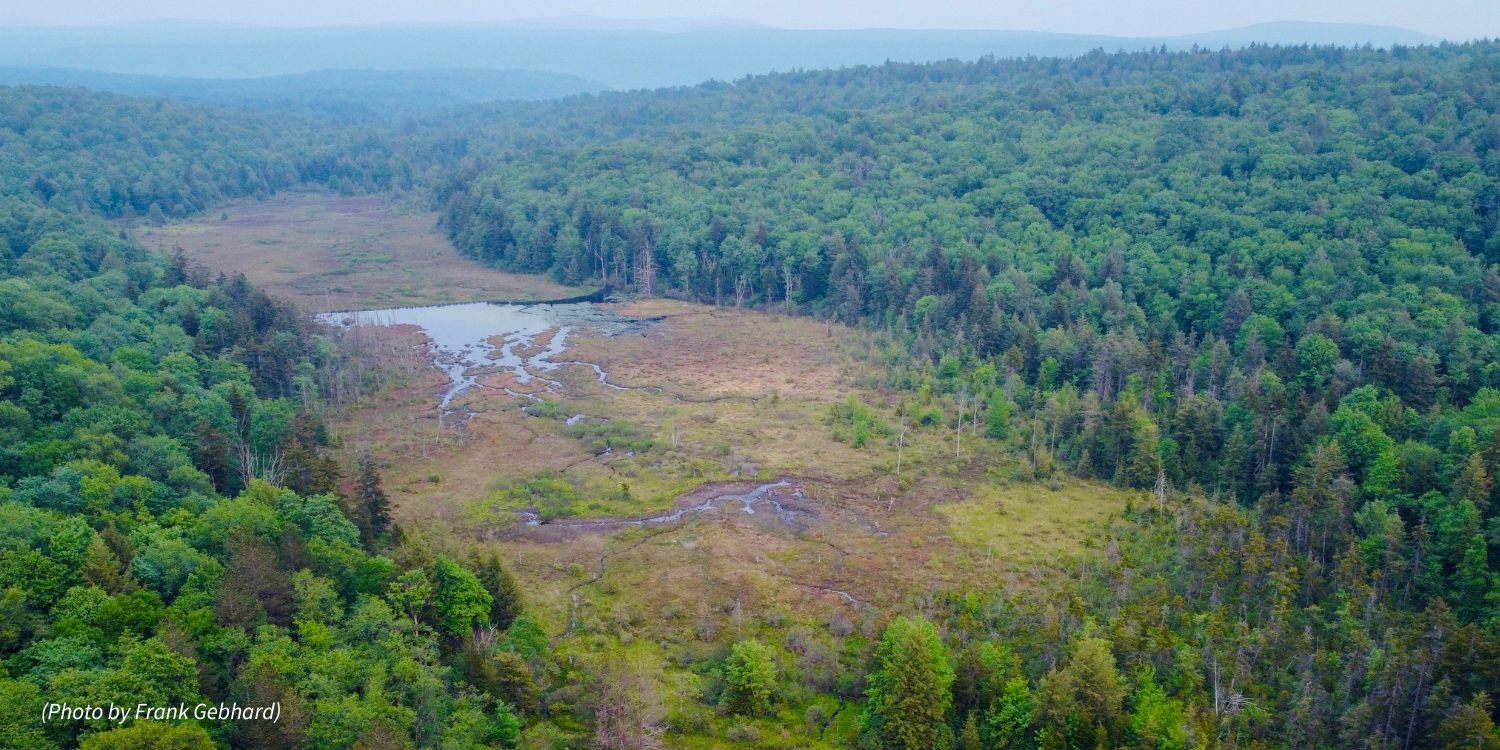By Susan Rogers Rosenblum
Big Run Bog, located in Tucker County, is a sometimes overlooked diamond in the crown of West Virginia. It is a beautiful place to experience a high mountain bog, breathe pure air, marvel at pure water, to gaze upon numerous rare plants and gather cranberries in the fall. The National Park Service describes it as “a site that contains a high altitude northern sphagnum-red spruce bog far south of its normal range persisting as a Pleistocene relict community. It possesses a high degree of integrity and is thus a fine representative example of this fairly uncommon ecosystem in West Virginia.” (Clovis, Jesse F., Natural Landmark Brief, September 2009, U.S. Department of the Interior, National Park Service, National Natural Landmarks Program)
But, what is a bog? What is a National Natural Landmark? And why are we choosing to focus on this one right now when it has been around since the Pleistocene geological epoch, or Ice Age, that lasted from 2.85 million to 11,700 thousand years ago?
Formerly known as Olson Bog and Kramer Swamp, Big Run Bog is located at 3,200 feet on Backbone Mountain in the Cheat Ranger District of the Monongahela National Forest at the headwaters of Big Run of the Blackwater River. The Right Fork of Big Run flows out of the bog and is protected as a Tier 3 water, which indicates high-quality waters as evidenced by exceptionally healthy benthic macroinvertebrate communities and/or naturally reproducing trout streams. The National Park Service describes the location of the bog as “an amphitheater-shaped valley head” with “surrounding slopes that are forested with second-growth stands of beech-maple and mixed oaks creating a buffer zone, which protects the watershed of this important wetland. Red spruce and hemlock occur in patches in the bog and on its periphery.” (Clovis)
The bog overall is a 731-acre tract that contains a 50-acre northern sphagnum bog that has peat deposits reported as seven to nine feet deep and features highbush blueberry, cranberry, sundew, pitcher plants and grass-pink and rose-pink orchids as well as other rare plants. A survey conducted by Robert Hunsucker, Dorothy Simpkins and Thomas DeMeo in 1994 and 1995 for the Northeastern Forest Experiment Station of the United States Forest Service reported that six species of rare vascular plants were found in a total vascular flora of 194 species. Many of the rare plants are at the extremes of their range, and “The diversity of habitats from mixed oak and beech-maple forests to northern sphagnum-red spruce bog makes this area valuable as a refuge for a large variety of biota.” It is a very special place.

Recognizing the unique nature of this bog, the Department of the Interior designated it as a National Natural Landmark in December 1974. A National Natural Landmark is a site that contains “outstanding biological and geological resources. Sites are designated by the Secretary of the Interior for their condition, illustrative character, rarity, diversity, and value to science and education.” (nps.gov/national natural landmarks) Despite being designated as a national treasure, ownership of a National Natural Landmark is not acquired by the Department of the Interior, and title and control of the site remains with the landowner. In this case, the federal government owns Big Run Bog National Natural Landmark as part of the Monongahela National Forest. Therefore, the protection and conservation of Big Run Bog rests with the Monongahela National Forest.
So, what is a bog? A bog is a type of wetland called a peatland. Peatlands are formed by peat-forming plants, such as mosses, that are waterlogged and decompose slowly, forming a thick vegetative mat below the living plants on the top. Sphagnum-dominated bogs such as Big Run Bog are typically “located in a frost pocket in the headwaters of small mountain streams.” (Wieder, et al. Vegetational Analysis of Big Run Bog, A Nonglaciated Sphagnum Bog in West Virginia, Department of Biology, West Virginia University) A bog forms above the water table and receives water and nutrients from rain and runoff from the surrounding watershed. It may also receive groundwater which gives it characteristics of a fen. Often, there is an intermixing of the two. The water in a bog is naturally highly acidic and the pH in the surface waters of Big Run Bog were reported by Hunsucker, et al. as having an average pH of 4.02. This pH is consistent with the pH readings that are being taken monthly by citizen scientists on the Right Fork of Big Run, which drains out of Big Run Bog.

Why are we so interested in Big Run Bog National Natural Landmark at this time? If you have ever had the good fortune to visit Big Run Bog or drive along Forest Road 17 to the Olson Fire Tower, or have even climbed the tower, you will understand how the Big Run Bog watershed drops off to the south of the road and that the watershed for Slip Hill Mill Run, another Tier 3 water, drops off to the north of the road. The road runs along the spine of Backbone Mountain. Theoretically, if you pour your water bottle out on one side of the road, it flows into one, out the other side, it flows into the other. Despite the fragile nature of the ecosystems on either side of Backbone Mountain, The West Virginia Division of Highways has planned its preferred route for Corridor H (ROPA) to travel along this spine. It has been described by our own Hugh Rogers as “threading the needle.” It is hard to conceive of a road any larger than Forest Road 17, let alone a highway, being able to be constructed without having a large destructive impact on either watershed, particularly Big Run Bog.
Currently up for approval is a permit for core drilling in the Monongahela National Forest in the Big Run and Slip Hill Mill Run watersheds to collect core samples along the ROPA to determine the geologic make-up of the soils and rock of the area and thus inform the design of the highway. Core drilling on private land along the ROPA has commenced from Mackeyville to the Tucker County High School, where it has stopped, presumably until a determination is made between a northern alternative or the ROPA, which would diverge at that point. However, the separate permit for the core drilling in the Monongahela National Forest has not yet been approved by the Department of Environmental Protection.
A virtual informational meeting and hearing will take place on Tuesday, December 19 from 6-8 p.m. The public will be able to register to attend and submit questions that they would like to ask. The concern of West Virginia Highlands Conservancy is that the fragile nature and beauty of the ecosystems will be damaged if the core drilling is not done with care and the least impact as possible. It is our understanding that the Monongahela National Forest has not yet approved of this drilling permit.
If you are concerned about the impacts of the construction of Corridor H on Big Run Bog National Natural Landmark, please consider registering and attending the meeting on December 19. The formal notice containing information on the hearing, the comment period and a link for registration is also in this edition of The Highlands Voice.
If you are interested in learning more about Big Run Bog and are perhaps considering a visit, I encourage you to read Big Run Bog-An Unexpected Road Trip at https://bit.ly/47xsJ63. It features good information regarding the nature of visiting a bog and wonderful photographs of some of the rare plants that you may see. In addition, Friends of Blackwater has produced a beautiful YouTube video featuring the Insect-Eating Plants at Big Run Bog https://bit.ly/3Rl5uWV.

